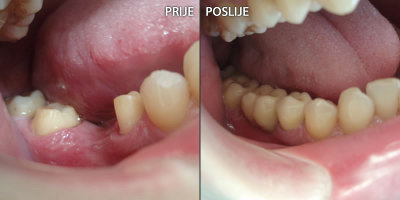
Fixed and mobile prosthetics
Fixed prosthetics
Fixed prosthetics comprises the making of dental crowns and bridges. Both devices are cemented in the mouth of the patient and the patient can not remove them.
Dental crown is a prosthetic cover of a tooth. There are several types of dental crowns:
Acrylic crown serves as a temporary solution until completion of permanent prosthetic device. It is made on the same day.
Metal ceramic crown is an aesthetic crown made of either gold platinum alloy or cobalt chrome molybdenum alloy. Cobalt chrome molybdenum alloy does not contain nickel and hence does not cause allergy. Porcelain (dental ceramics) is then applied to the alloy to which it chemically binds.
Metal free ceramic crown (with alloy free base) is indicated for the front teeth.
Metal free zirconia crown belongs the top devices of the cosmetic dentistry. It is composed of the zirconia cap and dental ceramic which is applied to the top of the cap. Contrary to the metal crown, the zirconia crown is white and mimics light refraction and translucency of the natural teeth. This crown is mainly fitted on the front teeth but could be fitted onto the rear teeth too.
A bridge is a prosthetic substitute of two or more teeth. It is used to replace the missing teeth by joining permanently to adjacent teeth or dental implants. The same materials used for making of dental crowns are used for making of the bridge.
Mobile prosthetics
Mobile prosthetics refers to prosthetic devices that a patient alone is able to place and remove from their mouth.
Dentures are devices utilised to replace missing teeth. There are two types of dentures. Complete or full dentures are for patients who are missing all of their teeth. Partial dentures are for patients who are missing some of their teeth.
It is important to ensure the appropriate adhesion force for the dentures to be securely fitted in the mouth. For the stability of the lower dentures, the force of gravity is also utilised. Stability of the partial dentures is achieved with retention forces. Retention is the principle that describes how well the denture is prevented from moving vertically. In partial dentures, clasps are major provider of retention. However they are visible and can interfere with a smile. There are also dentures with the so called “attachments” instead of clasps which are invisible and more firm, providing greater security and better appearance.
Teeth that are implanted into the dentures are of high quality and multi-layered and the refraction of light resembles that of natural teeth.
If the anatomical irregularities in patient's mouth challenge the fabrication of the denture and the achievement of the necessary stability, we recommend the option of dental implants (see implantology).







